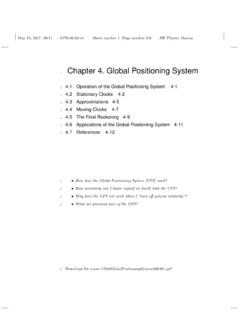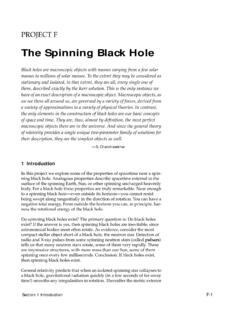Transcription of Global Positioning System
1 Section 1 Operation of the GPS A-1 project A Global Positioning System There is no better illustration of the unpredictable payback of fundamental science than the story of Albert Einstein and the Global Positioning System [GPS] .. the next time your plane approaches an airport in bad weather, and you just happen to be wondering "what good is basic science," think about Einstein and the GPS tracker in the cockpit, guiding you to a safe landing. Clifford Will 1 Operation of the GPS Do you think that general relativity concerns only events far from com-mon experience? Think again! Your life may be saved by a hand-held receiver that listens to overhead satellites, the System telling you where you are at any place on Earth. In this project you will show that this sys-tem would be useless without corrections provided by general Global Positioning System (GPS) includes 24 satellites, in circular orbits around Earth with orbital period of 12 hours, distributed in six orbital planes equally spaced in angle.
2 Each satellite carries an operating atomic clock (along with several backup clocks) and emits timed signals that include a code telling its location. By analyzing signals from at least four of these satellites, a receiver on the surface of Earth with a built-in microprocessor can display the location of the receiver (latitude, longi-tude, and altitude). Consumer receivers are the approximate size of a hand-held calculator, cost a few hundred dollars, and provide a position accurate to 100 meters or so. Military versions decode the signal to pro-vide position readings that are more accurate the exact accuracy a military secret. GPS satellites are gradually revolutionizing driving, flying, hiking, exploring, rescuing, and map use one GPS receiver at the control tower and one on the approaching airplane. The two receivers are close together, which cancels errors due to propagation of signals between each receiver and overhead satellites.
3 It also cancels the jitter intentionally introduced into the satel-lite signal to make civilian receivers less accurate than military receivers. A-2 P ROJECT A Global Positioning System As a result, measurement of the relative position of control tower and air-plane is accurate to 1 or 2 meters. This configuration of receivers permits blind landing in any weather. Runway collisions can also be avoided by using this System to monitor positions of aircraft on the ground (a task impossible for the electromagnetic signals of radar).The timing accuracy required by the GPS is so great that general relativis-tic effects are central to its performance. First, clocks run at different rates when they are at different distances from a center of gravitational attrac-tion. Second, both satellite motion and Earth rotation must be taken into account; neither the moving satellite nor Earth s surface corresponds to the stationary spherical shell described in Chapter 2.
4 In this project you will investigate these challenge in this project (and in all later projects) is to respond to the numbered queries. (Query 1 for this project appears on page A-4.) Typi-cally, a query contains several related questions. Answer the queries in order, or as assigned to you, or skip to those that interest you the most. 2 Stationary Clocks Earth rotates and is not perfectly spherical, so, strictly speaking, the Schwarzschild metric does not describe spacetime above Earth s surface. But Earth rotates slowly and the Schwarzschild metric is a good approxi-mation for purposes of analyzing the Global Positioning System . [1]Apply this equation twice, first to the orbiting satellite clock and second to a clock fixed at Earth s equator and rotating as Earth turns.
5 Both the Earth clock and the satellite clock travel at constant radius around Earth s center. Operation of the Global Positioning SystemThe goal of the Global Positioning System (GPS) is to deter-mine your position on Earth in three dimensions: east-west, north-south, and vertical (longitude, latitude, and altitude). Signals from three overhead satellites provide this informa-tion. Each satellite sends a signal that codes where the satellite is and the time of emission of the signal. The receiver clock times the reception of each signal, then sub-tracts the emission time to determine the time lapse and hence how far the signal has traveled (at the speed of light). This is the distance the satellite was from you when it emit-ted the signal. In effect, three spheres are constructed from these distances, one sphere centered on each satellite. You are located at the single point at which the three spheres course there is a wrinkle: The clock in your hand-held receiver is not nearly so accurate as the atomic clocks carried in the satellites.
6 For this reason, the signal from a fourth overhead satellite is employed to check the accuracy of the clock in your hand-held receiver. This fourth signal enables the hand-held receiver to process GPS signals as though it contained an atomic exchanged by atomic clocks at different altitudes are subject to general relativistic effects described using the Schwarzschild metric. Neglecting these effects would make the GPS useless. This project analyzes these 212Mr-------- dt2dr212Mr-------- ----------------- r2d 2 = Section 2 Stationary Clocks A-3 So dr = 0 for each clock. Divide the Schwarzschild metric through by the square of the far-away time dt 2 to obtain, for either clock,[2]Here d is the wristwatch time between ticks of either clock and v = r d / dt is the tangential velocity along the circular path of the same clock as measured by the bookkeeper using far-away time measurement.
7 Write down equation [2] first for the satellite, using r = r satellite , v = v satellite , and d = dt satellite between ticks of the satellite clock, second for the Earth clock, using r = r Earth , v = v Earth and time d = dt Earth between ticks of the Earth clock, all these for the same time lapse dt on the far-away clock. Divide corresponding sides of these two equations to obtain the squared ratio of time lapses recorded on the satellite and earth clocks:[3]The general relativistic effects we study are small. How small? Small com-pared to what? When must one use exact general relativistic expressions? When are approximations good enough? These questions are so central to the analysis that it is useful to begin with a rough estimate of the size of the expected effects, not worrying for now about the crudeness of this by ignoring the motions of satellite clock and Earth surface clock.
8 Ask instead what the difference in clock rates will be for stationary clocks at these two radii. Then equation [3] can be written[4]You will show in Query 7 that the radius of a 12-hour circular orbit is about 10 6 meters from Earth s center. You will find values for the radius and mass of Earth among the constants inside the back cover. We now make first use of an approximation that appears repeatedly in this project :[5]Here the two vertical lines mean absolute value. d dt----- 212Mr-------- r2d dt------ 2 12Mr-------- v2 ==dtsatellitedtEarth-------------------- 212 Mrsatellite----------------- vsatellite2 12 MrEarth------------- vEarth2 ---------------------------------------- -----------=dtsatellitedtEarth---------- ----------12 Mrsatellite----------------- 12 12 MrEarth------------- 12 ---------------------------------------- - 12 Mrsatellite----------------- 12 12 MrEarth------------- 1 2 =1d+()n1nd provided+ d1 and nd1 A-4 P ROJECT A Global Positioning System Approximation [5] is accurate for any real (positive or negative, integer or fractional) value of the exponent n provided the absolute values of d and nd are both very much less than unity.
9 Equation [5] is used so often in this book that it is rewritten for general reference as equation [E] on the last page of the number represented by b in equation [8] is an estimate of the frac-tional difference in rates between stationary clocks at the position of the satellite and at Earth s surface. Is this difference negligible or important to the operation of the GPS? Suppose the timing of a satellite clock is off by 1 nanosecond (10 9 second). In 1 nanosecond a light signal (or a radio wave) propagates approximately 30 centimeters, or about one foot. So a differ-ence of, say, hundreds of nanoseconds will create satellite clock will run fast by something like 50 000 nanoseconds per day compared with the clock on Earth s surface due to position effects alone. Clearly general relativity is needed for correct operation of the Glo-bal Positioning Satellite System !
10 On the other hand, the fractional difference between clock rates at the two locations (at least the fraction due to difference in radius) is 1 Formula: Clock rate difference due to height. Apply approximation [5] to the two parenthetical expressions on the right of equation [4]. Multiply out the result to show that[6. for v = 0]QUERY 2 Improved approximation. What are the approximate values of M/rEarth and M/rSatellite? Make an argument that the last term on the right of [6] can be neglected in comparison with the other terms on the right, leading to the result for stationary satellite and Earth clocks:[7. for v = 0]QUERY 3 Numerical approximation. Substitute numbers into equation [7] and find the numerical value of b in the following equation:[8. for v = 0]dtsatellitedtEarth-------------------- 1 Mrsatellite----------------- MrEarth-------------Mrsatellite--------- -------- MrEarth------------- + dtsatellitedtEarth--------------------1 Mrsatellite----------------- MrEarth-------------+ dtsatellitedtEarth--------------------1b + QUERY 4 Synchronization discrepancy after one day.









